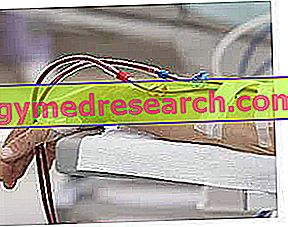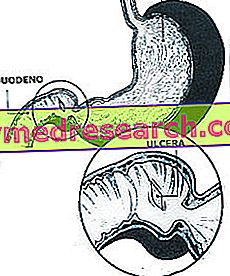Generality
Homocysteine is an amino acid that is normally present in very small quantities in the cells of the body.

What's this
Homocysteine is a sulfur amino acid (ie containing a sulfur atom), whose metabolism is regulated thanks to the intervention of enzymes and vitamins. This element derives, in particular, from the demethylation of methionine (an essential amino acid that the body can only derive from food).
Once produced inside the cells, homocysteine is rapidly metabolized and converted into other products. In these processes, the intervention of vitamins B6 and B12 and folates is essential, whose possible deficiency can be evidenced precisely by the increase in plasma homocysteine. If prolonged and not adequately treated, this nutritional deficiency can be associated with the increased risk of incurring cardiovascular diseases.
Why do you measure
Homocysteine testing measures plasma or urine levels.
This evaluation can be used for various purposes:
- Identify a deficiency of folic acid or vitamin B12;
- Determine the presence of an increased cardiovascular risk, based on age and the presence of other factors that may predispose to stroke or heart attack.
- As part of neonatal screening, in case of suspected diagnostic of homocystinuria.
homocystinuria
Homocystinuria is a rare hereditary disease; subjects who are affected typically have very high homocysteine values in their blood and urine (they can even exceed 100 umol / L). Homocystinuria can be caused by mutations of different genes, which encode enzymes involved in amino acid disposal mechanisms. This defect therefore leads to the formation of anomalous enzymes, not working or capable of only partially metabolizing the precursor of homocysteine (methionine). Without the enzymes responsible for the normal metabolism of these compounds, homocysteine and methionine accumulate in the body.
Children with this condition may appear normal at birth, but within a few years they may show the first clinical signs. These manifestations include congenital dislocation of the lens, mental retardation, skeletal abnormalities, osteoporosis and behavioral disorders. Furthermore, homocystinuria involves an increased risk of vascular thromboembolism and atherosclerosis which can lead to the premature development of cardiovascular diseases.
Early diagnosis of the disease helps alleviate these symptoms; for this reason, homocysteinemia was included among neonatal screening.
Normal values
The values of homocysteine in the blood are considered physiological when they are in the range 5-12 micromoles per liter (µmol / L).
High Homocysteine - Causes
An excess of homocysteine ( hyperhomocysteinemia ) is a condition that can be determined by several factors.

The signs and symptoms of a deficiency of vitamin B12 and folate can initially be subtle and non-specific; these may include:
- Diarrhea;
- Dizziness;
- Sense of fatigue and weakness;
- Loss of appetite;
- Pallor;
- Accelerated heart beat;
- Shortness of breath;
- Pain in the mouth and tongue;
- Tingling, numbness and / or burning on the feet, hands, arms and legs (with vitamin B12 deficiency).
Homocysteinemia makes it possible to detect the deficiency in people with an initial deficit, before obvious and more serious manifestations occur.
Other causes of hyperhomocysteinemia are the use of certain types of drugs (such as carbamazepine, methotrexate and fentoina) or pathologies at the kidney level. In fact, homocysteine is eliminated from the body through the urine, in the form of cystine. In the presence of nephropathy, the excretion of all waste products decreases and, consequently, the levels of this amino acid in the blood increase.
The increase in the blood values of homocysteine (hyperhomocysteinemia) may also depend on genetic causes, as in the case of homocystinuria.
Homocysteine levels may also increase with age, in smokers and in post-menopausal women.
Possible consequences
The increase in blood levels of homocysteine is associated with the risk of developing heart and vascular diseases, including stroke, atherosclerosis and myocardial infarction.
The mechanism by which homocysteine is associated with an increased predisposition to heart attack and stroke is not yet fully understood, but appears to be due to alterations in coagulation and endothelial damage.
Many scientific studies, then, support the benefits or the decrease in cardiovascular risk due to the intake of folic acid and vitamin B supplements. Despite this consideration, however, homocysteine is not among the main risk factors for cardiovascular diseases (as is smoking, hypertension or obesity) and its use as part of the screening of these conditions is still a matter of debate.
Hyperhomocysteinemia is related to various other consequences, such as predisposition to develop bone fragility, neurodegenerative pathologies (such as senile dementia and Alzheimer's disease) and preeclampsia during pregnancy.
Low Homocysteine - Causes
Low plasma homocysteine levels are not usually associated with medical problems and / or pathological consequences, therefore they are not considered clinically relevant.
How to measure it
The determination of the homocysteine values is carried out on a venous blood sample. Sometimes, in addition to blood sampling, the collection of a urine sample may also be required.
Preparation
The sample is usually taken in the morning, after a fast of 10-12 hours.
Different drugs can lead to an increase or decrease in homocysteine values. Therefore, it is always advisable to inform your doctor of any treatment, including phytotherapy, to which you are subjected so as to correctly interpret the result of the analysis.
Interpretation of Results
A high level of homocysteine in the blood (hyperhomocysteinemia) is a condition that can be attributed to several causes. A deficiency of vitamins B12, B6 and folic acid favors the accumulation of the amino acid in the circulation. Other determining factors of hyperhomocysteinemia are the use of some types of drugs, renal pathologies and homocystinuria.
Cardiovascular risk
High levels of homocysteine in the blood are associated with an increased cardiovascular risk, therefore more likely to suffer from diseases such as heart attack, intermittent claudication, ischemic heart disease, etc. The values of homocysteine in plasma are considered normal when they are around 5-12 micromoles per liter (5-12 µmol / L), borderline for higher levels, up to 15 µmol / L, and excessively high when they exceed this threshold. The optimal levels of homocysteine are instead around 7 µmol / L.
Although there is some variability between the various guidelines, we can consider the following table as a reference point.
| Normal homocysteine values | High homocysteine values | Therapeutic goal | |||
| Lower limit | Upper limit | ||||
| Women | 12-19 years | 3.3 μmol / L | 7.2 μmol / L | > 10.4 μmol / L | <6.3 μmol / L (<0.85 mg / L) |
| > 60 years | 4.9 μmol / L | 11.6 μmol / L | |||
| Men | 12-19 years | 4.3 μmol / L | 9.9 μmol / L | > 11.4 μmol / L | |
| > 60 years | 5.9 μmol / L | 15.3 μmol / L | |||
Too high values of homocysteine can be reported in the standard by increasing the intake of folate and B vitamins, in particular B6 and B12. In these cases, the doctor therefore tends to recommend a greater consumption of whole grains, including those for breakfast, spinach, asparagus, lentils and most legumes. While vegetables - as long as they are eaten fresh and raw or at most steamed - are good sources of folic acid, vitamins B6 and B12 are typical of meat and fish. Once the eating habits are corrected, if the homocysteine values remain high, it is necessary to resort to fortified foods, still not widespread in Italy, or to specific supplements. It must be said, however, that it is still unclear whether the reduction of homocysteine values is actually useful for reducing cardiovascular risk. Furthermore, if you really want to promote the health of your heart and your blood vessels, you need to consider the total risk profile, therefore all the various dietary aspects (saturated fats, cholesterol, fibers, simple sugars, etc.), behavioral (smoking, sedentary) and clinical (triglycerides, cholesterol, glycemia, PCR and other inflammatory markers).



